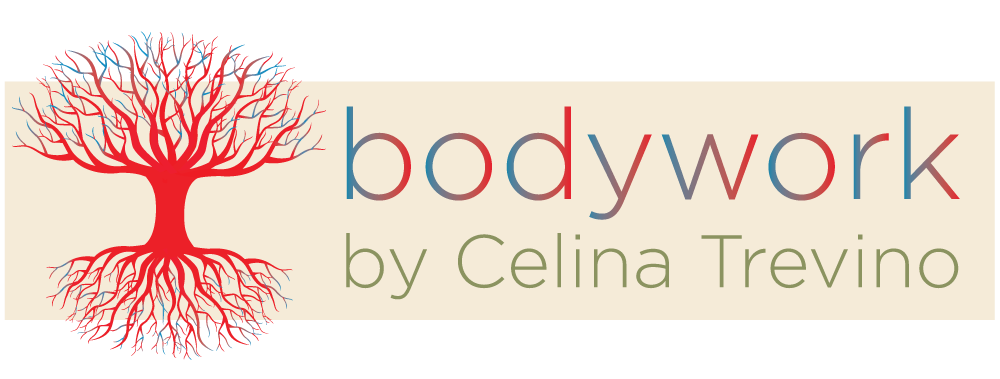Bodywork
Bodywork
The terms bodywork and massage are usually used interchangeably. Simply put, bodywork is any manual (hands-on) technique that is not massage. Bodywork is holistic in its thought process and application. Celina applies a whole person approach, including your emotions, lifestyle, spirituality, exercise and nutrition. What it all comes down to is, do you care about the way you feel? In Celina’s Bodywork, the goal is to help normalize your body’s tissues, so that you will feel better and function more efficiently.
Modalities
Visceral Manipulation gently restores mobility (range of motion) and motility (inherent movement) to the organs of the chest, abdomen and pelvis. The amount of pressure used is about 25 grams, or that of a quarter. Any time we experience trauma or accidents, the organs get moved as much as the rest of the body and will experience a loss of motion and function will be suboptimal. Restoring the natural movement to the organ can help with its function.
Neural Manipulation is a very light, almost feathery touch that supports the nerves in the gliding action they must have to function properly and not be irritated.
Myofascial Release aims to release the tense myofascia or muscles and fascia. Fascia is connective tissue that is located all over your body. It envelopes everything; each muscle, each muscle group, the nerves, blood vessels, etc. It is said that if everything other than fascia were removed from the body, a 3-D diagram of the body would remain. Restrictions in the myofascia interfere with range of motion and impact blood supply and nerve function. The fascia can be released either by stretching it in the way it doesn’t want to go, or going in the direction the tissues prefer to move.
Craniosacral Therapy is a gentle application of the hands, about 5 grams or the weight of a nickel, to the bones of the head and face or sacrum to affect the tissues or membranes that connect the head to the sacrum. This system also has its own mobility and motility that can become disturbed and influence the rest of the body in a suboptimal way. The cranial rhythm can also be felt at any area of the body so is used to monitor and locate areas of restriction.
Muscle Energy consists of five different techniques that use the person’s natural body movements to increase range of motion. It is an active process on the client’s part, as opposed to the therapist acting with the client’s tissues. The techniques can use the client’s gentle muscle contractions, breathing and gentle eye movements to relax or lengthen muscles and strengthen weak muscles.
Strain Counterstrain is a gentle technique that can be used on ‘tender points’, or areas of irritability, that when applied with pressure, feel like a bruise. These points signal a muscle that is contracted and leads to decreased circulation, pain, and limited range of motion. Usually these points are a result of trauma to the body. The technique is comprised of monitoring the tender point, while positioning the person into ease or comfort. The tenderness decreases or vanishes. This position is then held for 90 seconds and the therapist gently returns the body part to its neutral position. The result is decreased pain, increase in local circulation and better range of motion.
Trigger Point Therapy is a gentle way of approaching ‘trigger’ or hyperirritable spots that may refer pain to other areas. A person will have pain, weakness and limited range of motion in a part of their body, not realizing the origin of their pain is coming from a point of irritation at another location. For example, pain that radiates up along the side of the head to the temple may feel like a headache, and could be coming from a trigger point in the upper trapezius muscle. Once areas have been palpated by a therapist, people are sometimes surprised at the existence of their trigger or tender points. Trigger points are addressed with pressure and/or massage, and then stretched. The result is an elimination of referred pain and increased range of motion.
Shiatsu means ‘thumb and finger pressure’. This type of pressure is gentle but deep. The gentle application allows the thumbs to go deeper into the tissues. It is NOT deep tissue massage. The idea behind shiatsu is to follow the muscle path from origin to insertion and relieve pressure on the nerves. The correct amount of pressure will result in a resetting of the muscle spindle – a nerve inside your muscle that determines its tension. Deep pressure will inhibit the nerve, and cause relaxation of the muscle. A quicker type of pressure applied will have the opposite effect: to stimulate the muscle spindle and result in a higher tone of the muscle. Shiatsu can be used to relax or tonify muscles. Shiatsu can be used for insomnia, whiplash, any type of nerve entrapment such as sciatica or carpal tunnel syndrome and much more.
Neuro-Sensory-Motor Reflex Integration is a very effective modality that is helpful for children and adults with trauma, stress, neurodeficits or giftedness. This method involves various massage techniques, exercises, specific movements, muscle strengthening and reflex re-patterning in order to integrate reflexes. Please see my blog for an explanation of the benefits of this method.
Research
All of the bodywork techniques I use have much scientific research demonstrating their efficacy. Please see this partial list:
